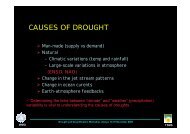CLIMATOLOGY And It's APPLICATION - RTC, Regional Training ...
CLIMATOLOGY And It's APPLICATION - RTC, Regional Training ...
CLIMATOLOGY And It's APPLICATION - RTC, Regional Training ...
Create successful ePaper yourself
Turn your PDF publications into a flip-book with our unique Google optimized e-Paper software.
However, climate observations differ in a number of important respects.<br />
Climate observations need to account for the full range of elements that describe<br />
the climate system – not just those that describe the atmosphere. Extensive<br />
observations of the ocean and terrestrial-based systems are required.<br />
An observation at any point in time needs a reference climate against which it can<br />
be evaluated, i.e. a reference climatological period must be selected. In this regard,<br />
the observations from a station that only exists for a short period (i.e. from days to a<br />
few years) or which relocates very frequently will generally be of less value than<br />
those observations from a station whose records have been maintained to established<br />
standards over many years. Thus, in order to derive a satisfactory climatological<br />
average (or normal) for a particular climate element, a sufficient period record of<br />
homogeneous, continuous and good quality observations for that element is<br />
required.<br />
A climate observation should be associated – either directly or indirectly - with a<br />
set of metadata that will provide users with information, often implicitly, on how the<br />
observation should be interpreted and used. Other differences can be inferred from<br />
the sections that follow. So, while climate observations serve multiple purposes<br />
beyond specific climate needs, we must ensure that they retain, and acquire,<br />
particular characteristics that serve a range of climate needs.
















